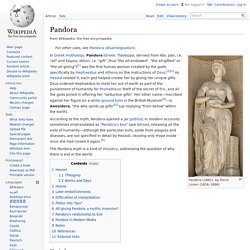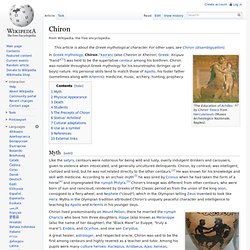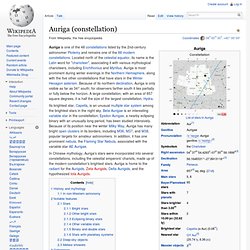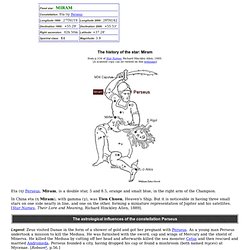

WASP-12b. WASP-12b is an extrasolar planet orbiting the star WASP-12, discovered by the SuperWASP planetary transit survey.

Its discovery was announced on April 1, 2008.[1] Due to its extremely close orbit to its star, it has one of the lowest densities for exoplanets ('inflated' by the flux of energy from the star). The planet takes only a little over a day to orbit the star, in contrast to 365 days for the Earth to orbit the Sun. Pandora. According to the myth, Pandora opened a jar (pithos), in modern accounts sometimes mistranslated as "Pandora's box" (see below), releasing all the evils of humanity—although the particular evils, aside from plagues and diseases, are not specified in detail by Hesiod—leaving only Hope inside once she had closed it again.[6] The Pandora myth is a kind of theodicy, addressing the question of why there is evil in the world.

Hesiod[edit] Hesiod, both in his Theogony (briefly, without naming Pandora outright, line 570) and in Works and Days, gives the earliest version of the Pandora story. Theogony[edit] The Pandora myth first appears in lines 560–612 of Hesiod's poem in epic meter, the Theogony (ca. 8th–7th centuries BC), without ever giving the woman a name.
From her is the race of women and female kind: of her is the deadly race and tribe of women who live amongst mortal men to their great trouble, no helpmates in hateful poverty, but only in wealth. Works and Days[edit] Chiron. In Greek mythology, Chiron /ˈkaɪrən/ (also Cheiron or Kheiron; Greek: Χείρων "hand"[1]) was held to be the superlative centaur among his brethren.

Chiron was notable throughout Greek mythology for his kourotrophic (bringer up of boys) nature. His personal skills tend to match those of Apollo, his foster father (sometimes along with Artemis); medicine, music, archery, hunting, prophecy. CHIRON The Wise Centaur Greek mythology, Kheiron, w- pictures constellation Saggitarius. Auriga (constellation) The first record of Auriga's stars was in Mesopotamia as a constellation called GAM, representing a scimitar or crook.

However, this may have represented just Capella (Alpha Aurigae) or the modern constellation as a whole; this figure was alternatively called Gamlum or MUL.GAM in the MUL.APIN. The crook of Auriga stood for a goat-herd or shepherd. It was formed from most of the stars of the modern constellation; all of the bright stars were included except for Elnath, traditionally assigned to both Taurus and Auriga. Later, Bedouin astronomers created constellations that were groups of animals, where each star represented one animal. Stomach (Chinese constellation) Pandora. Miram. From p.334 of Star Names, Richard Hinckley Allen, 1889.

[A scanned copy can be viewed on this webpage] Eta (η) Perseus, Miram, is a double star, 5 and 8.5, orange and smalt blue, in the right arm of the Champion. In China eta (η Miram), with gamma (γ), was Tien Chuen, Heaven's Ship. But it is noticeable in having three small stars on one side nearly in line, and one on the other, forming a miniature representation of Jupiter and his satellites. Eta Persei. Name and etymology[edit]

The Killing Moon. In a retrospective review of the song, Allmusic journalist Stewart Mason wrote: "The smart use of strings amplifies the elegance of the tune, bringing both a musical richness and a sense of quiet dignity to the tune".[2] Lyrics[edit] Track listing[edit] UK 12""The Killing Moon" (All Night Version) – 9:11"The Killing Moon" – 5:50"Do It Clean" (Recorded live at the Royal Albert Hall London 18 July 1983) – 2:45 In popular culture[edit] Cover versions[edit] "The Killing Moon" has been covered by many artists:[3]

Planetary objects proposed in religion, astrology, ufology and pseudoscience. There are a number of planets or moons whose existence is not supported by scientific evidence, but are proposed by various astrologers, pseudoscientists, conspiracy theorists, or certain religious groups.

Central Fire and Counter-Earth[edit] Auriga.
Sirius. Sirius appears bright because of both its intrinsic luminosity and its proximity to Earth.

At a distance of 2.6 parsecs (8.6 ly), as determined by the Hipparcos astrometry satellite,[5][19][20] the Sirius system is one of Earth's near neighbors. Sirius is gradually moving closer to the Solar System, so it will slightly increase in brightness over the next 60,000 years. After that time its distance will begin to recede, but it will continue to be the brightest star in the Earth's sky for the next 210,000 years.[21] Sirius A is about twice as massive as the Sun (M☉) and has an absolute visual magnitude of 1.42. It is 25 times more luminous than the Sun[7] but has a significantly lower luminosity than other bright stars such as Canopus or Rigel.
Chiron. Chromium.